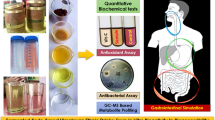Abstract
In this research, some herbal teas and infusions traditionally used in the treatment of diabetes in Turkey, have been studied for their antidiabetic effects on in vitro glucose diffusion and phenolic contents and antioxidant activities. Ten aqueous herbal tea extracts were examined using an in vitro method to determine their effects on glucose movement across the gastrointestinal tract. Total phenol content of herbal teas was analyzed by Folin–Ciocalteu’s procedure. Antioxidant activities of herbal teas were evaluated by the effect of extracts on DPPH radical and hydrogen peroxide scavenging. Antioxidant activity was defined as the amount of the sample to decrease the initial DPPH· concentration by 50% as efficient concentration, EC50. Antiradical activity [AE] was calculated as 1/EC50. Values were evaluated statistically. Results support the view that none of the herbal teas showed antidiabetic effect on glucose diffusion using in vitro model glucose absorption. Teas were arranged in the order of green tea > peppermint > thyme > black tea > relax tea > absinthium > shrubby blackberry > sage > roselle > olive leaves according to their total phenol contents. Among ten herbal teas, green tea had the highest hydrogen-donating capacity against to DPPH radical. Ranking of the herbal teas with respect to their DPPH radical scavenging activity were green tea > peppermint > black tea > thyme > relax tea > absinthium > roselle > olive leaves > sage > shrubby blackberry. It was determined that adding flavoring substances such as lemon, bergamot, clove and cinnamon, which are commonly used in preparation of black tea in Turkey resulted to have synergistic effect on total antioxidant activities of black and peppermint teas. The highest hydrogen peroxide inhibition value (65.50%) was obtained for green tea at a 250 µl/ml concentration. The H2O2 scavenging activity of herbal teas decreased in the order green tea > peppermint > relax tea > black tea > thyme > olive leaves > sage > absinthium > shrubby blackberry > roselle. In particular, their phenolic compounds and antioxidant activities may be useful for meal planning in type 2 diabetes. They could contribute to sustain plasma antioxidant level because antioxidants present in plants and herbs prevent the development of vascular diseases seen in type 2 diabetes.
Similar content being viewed by others
References
Grover JK, Yadav S, Vats V (2002) Medicinal plants of India with anti-diabetic potential. J Ethnopharmacol 81:81–100
McCune LM, Johns T (2002) Antioxidant activity in medicinal plants associated with the symptoms of diabetes mellitus used by the Indigenous Peoples of the North American boreal forest. J Ethnopharmacol 82:197–205
Gurib-Fakim A, Subratty H, Narod F, Govinden-Soulange J, Mahomoodally F (2005) Biological activity from indigenous medicinal plants of Mauritius. Pure Appl Chem 77(1):41–51
Ziegler EE, Filer LJ (1996) Present knowledge in nutrition. ILSI Press, Washington, DC
Berdanier CD (2002) Handbook of nutrition and food. CRC Press, New York
Facchini FS, Hua NW, Reaven GM, Stoohs RA (2000) Hyperinsulinemia: the missing link among oxidative stress and age-related disease? Free Radic Biol Med 29:1302–1306
Thompson KH, Godin DV (1995) Micronutrients and antioxidants in the progression of diabetes. Nutr Res 15(9):1377–1410
Kelble A (2005) Spices and type 2 diabetes. Nutr Food Sci 35(2):81–87
Alarcon-Aguilara FJ, Roman-Ramos R, Perez-Gutierrez S, Aguilar Contreras A, Contreras-Weber CC, Flores-Saenz JL (1998) Study of the anti-hyperglycemic effects of plants used as antidiabetics. J Ethnopharmacol 61:101–110
Chhetri DR, Parajuli P, Subba GC (2005) Antidiabetic plants used by Sikkim and Darjeeling Himalayan tribes. J Ethnopharmacol 99:199–202
Gallagher AM, Flatt PR, Duffy G, Abdel-Wahab YHA (2003) The effects of traditional antidiabetic plants on in vitro glucose diffusion. Nutr Res 23:413–424
Singleton VL, Rossi JA (1965) Colorimetry of total phenolics with phosphomolybdic-phosphotungstic acid reagents. Am J Enol Vitic 16:144–158
Shahidi F, Naczk M (1995) Food phenolics sources chemistry effects applications. Technomic, Lancaster, Basel
Brand-Williams W, Cuvelier ME, Berset C (1995) Use of a free radical method to evaluate antioxidant activity. LWT-Food Sci Tech 28:25–30
Parejo I, Codina C, Kefalas P (2000) Evaluation of scavenging activity assessed by Co(II)/EDTA-induced luminal chemiluminescence and DPPH (2,2-diphenyl-1-picrylhydrazyl) free radical assay. J Pharmacol Toxicol Methods 44(3):507–512
Wettasinghe M, Shahidi F (2000) Scavenging of reactive-oxygen species and DPPH free radicals by extracts of borage and evening primrose meals. Food Chem 70:17–26
Kumaran A, Karunakaran RJ (2007) In vitro antioxidant activities of methanol extracts of five Phyllanthus species from India. LWT-Food Sci Tech 40(2):344–352
Wood PJ, Beer MU, Butler G (2000) Evaluation of role of concentration and molecular weight of oat beta-glucan in determining effect of viscosity on plasma glucose and insulin following oral glucose load. Br J Nutr 84:19–23
Katalinic V, Milos M, Kulisic T, Jukie M (2006) Screening of medicinal plant extracts for antioxidant capacity and total phenols. Food Chem 94:550–557
Karakaya S, El SN (1999) Quercetin, luteolin, apigenin and kaempferol contents of some foods. Food Chem 66:289–292
El SN, Karakaya S (2004) Radical scavenging and iron chelating activities of some greens used as traditional dishes in Mediterranean diet. Int J Food Sci and Nutr 55:67–74
Ivanova D, Gerova D, Chervenkov T, Yankova T (2005) Polyphenols and antioxidant capacity of Bulgarian medicinal plants. J Ethnopharmacol 96:145–150
Karakaya S, El SN, Taş A (2001) Antioxidant activity of some foods containing phenolic compounds. Int J Food Sci Nutr 52:501–508
López V, Akerreta S, Casanova E, García-Mina JM, Cavero RY, Calvo MI (2007) In vitro antioxidant and anti-rhizopus activities of lamiaceae herbal extracts. Plant Foods Hum Nutr 62:151–155
Atoui AK, Mansouri A, Boskou G, Kefalas P (2005) Tea and herbal infusions: their antioxidant activity and phenolic profile. Food Chem 89:27–36
Author information
Authors and Affiliations
Corresponding author
Rights and permissions
About this article
Cite this article
Büyükbalci, A., El, S.N. Determination of In Vitro Antidiabetic Effects, Antioxidant Activities and Phenol Contents of Some Herbal Teas. Plant Foods Hum Nutr 63, 27–33 (2008). https://doi.org/10.1007/s11130-007-0065-5
Received:
Accepted:
Published:
Issue Date:
DOI: https://doi.org/10.1007/s11130-007-0065-5




